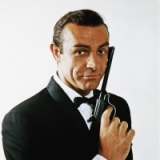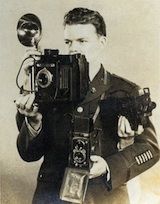- Forum
- General Discussion | Introductions | Off Topic Forum
- Photography General Discussion
- Why do they say full frame is better than cropped?
Why do they say full frame is better than cropped?
-

- Henry Peach
- Apprentice
-
- I currently use a 5DII or Sony Nex-3 most of the time.
- Followers: 50
- Posts: 2925
-
Points:
16
Post #110103
I have found that most of the time people, including experienced photographers, can't tell the difference between my large prints (up to 20"x30") shot with my 8mp APS-C Canon 20D and my 21mp 35mm 5DII. At least for ISOs 400 and slower.
-

- BCP
- New Kid On The Block
-
- Nikon D700 and D300s
- Followers: 6
- Posts: 46
-
Points:
0
Post #110115
Low light photography is certainly at the top of my list when the full frame body is the one to grab; it simply has better high ISO abilities.
Post #110120
So that is where my question came from.
-

- Henry Peach
- Apprentice
-
- I currently use a 5DII or Sony Nex-3 most of the time.
- Followers: 50
- Posts: 2925
-
Points:
16
Post #110150
Fiesta! wrote: He was talking to another person in the store today and kept saying "full frame is better than cropped any day of the week" over and over again
If that were true there would be little point in making APS-C format professional cameras. The reason there is a choice is because each has strengths and weaknesses that have to be assessed individually.
-

- Scotty
- Agent 007
- James Bond, PT mod.
- Followers: 1088
- Posts: 9873
-
Points:
14814
Post #110153
When the last candle has been blown out
and the last glass of champagne has been drunk
All that you are left with are the memories and the images-David Cooke.
-

- lucky1one
- Has the Hang of it
- Canon 1D Mark II
- Followers: 3
- Posts: 74
-
Points:
0
Post #110158
Advantages of full frame sensor cameras:
-could take full advantage of your wide angle lens. This is useful for shooting landscapes.
-better image quality when using high ISO. This is helpful when shooting in low light situations where flash is not available or permitted.
Disadvantage of full frame sensor cameras:
-more expensive bodies
-lenses are bigger
Advantages of crop sensor cameras:
-could take advantage of crop factor to take more detailed shots at longer distance. This is useful when shooting sports and wildlife.
-cheaper than full frame cameras.
Disadvantage of crop sensor cameras:
-could not take full advantage of the wide angle focal length of the lens.
-

- Henry Peach
- Apprentice
-
- I currently use a 5DII or Sony Nex-3 most of the time.
- Followers: 50
- Posts: 2925
-
Points:
16
Post #110236
As photographic technology improves, and the quality people want is available in a smaller camera, that format becomes popular. The consumer cameras of 120 years ago would be considered large format. Film got better and people switched to medium format folders and TLRs. By the late 20th century 35mm was good enough for most folks. Today APS-C digital doesn't have too much trouble matching, even beating, 35mm film.
Henri Cartier Bresson's peers told him 35mm was for amateurs and tourists. I think he proved them wrong.
So my question is how did 35mm, which used to be considered small format, become "full frame"? Why isn't 6x7cm or 4x5 or 8x10 full frame? They must be very full frame.
-

- BCP
- New Kid On The Block
-
- Nikon D700 and D300s
- Followers: 6
- Posts: 46
-
Points:
0
Post #110245
Henry Peach wrote: Many APS-C DSLRs have a faster flash sync speed than 35mm DSLRs.
As photographic technology improves, and the quality people want is available in a smaller camera, that format becomes popular. The consumer cameras of 120 years ago would be considered large format. Film got better and people switched to medium format folders and TLRs. By the late 20th century 35mm was good enough for most folks. Today APS-C digital doesn't have too much trouble matching, even beating, 35mm film.
Henri Cartier Bresson's peers told him 35mm was for amateurs and tourists. I think he proved them wrong.
So my question is how did 35mm, which used to be considered small format, become "full frame"? Why isn't 6x7cm or 4x5 or 8x10 full frame? They must be very full frame.
LOL, no they would be medium format and large format. The term 'full frame' refers to the imaging sensor being the same size as a frame of 35mm film. DSLR bodies are based on the same form factor as 35mm SLR bodies, thus the 35 mm comparison. A medium or loarge format camera is a completely different form factor.
-

- Stealthy Ninja
- Moderator
-
- Fuji X stuff and a 1DsIII for some reason
- Followers: 982
- Posts: 16300
-
Points:
6837
Post #123702
Henry Peach wrote: It's like saying Hum Vees are better than other vehicles. In some situations it may be true. In many others not so much.
I have found that most of the time people, including experienced photographers, can't tell the difference between my large prints (up to 20"x30") shot with my 8mp APS-C Canon 20D and my 21mp 35mm 5DII. At least for ISOs 400 and slower.
That't the point right?! 400 and lower ISO there won't be much difference, but FF is generally a lot better at higher ISO levels. It's not just the amount of grain either, it's the quality of the grain. I found it's much smoother and more even on FF cameras as opposed to crop cams.
That and more details, shallower DOF and full use of a lenses field of view make FF cameras the best choice.
Like Scotty said, only advantage is reach.
-

- Henry Peach
- Apprentice
-
- I currently use a 5DII or Sony Nex-3 most of the time.
- Followers: 50
- Posts: 2925
-
Points:
16
Post #123783
"Why do they say full frame is better than cropped?"
Because in general people like to say bigger is better, about almost everything. They make these generalizations because they don't want you to think or learn, they just want you to salivate over the next upgrade, and keep spending your money. Or they want to say my toys are better than your toys. Cameras have always come in a variety of formats, and the advantages and disadvantages of choosing a smaller or larger format are pretty much the same today as they were 100 years ago.
Here's an obvious advantage of smaller format: they are significantly cheaper. Not important to everyone, but some folks don't want to/can't spend $2000+ on a camera body.
-

- Scotty
- Agent 007
- James Bond, PT mod.
- Followers: 1088
- Posts: 9873
-
Points:
14814
Post #124002
Henry Peach wrote: You don't get more "reach" with a smaller format. A particular focal length on any format creates exactly the same image size on the sensor/film. The photographer is just asking the lab to enlarge it more, which of course could be done with photos from any camera of any format.
"Why do they say full frame is better than cropped?"
Because in general people like to say bigger is better, about almost everything. They make these generalizations because they don't want you to think or learn, they just want you to salivate over the next upgrade, and keep spending your money. Or they want to say my toys are better than your toys. Cameras have always come in a variety of formats, and the advantages and disadvantages of choosing a smaller or larger format are pretty much the same today as they were 100 years ago.
Here's an obvious advantage of smaller format: they are significantly cheaper. Not important to everyone, but some folks don't want to/can't spend $2000+ on a camera body.
Reach and FL are two different things.
When the last candle has been blown out
and the last glass of champagne has been drunk
All that you are left with are the memories and the images-David Cooke.
-

- MLKstudios
- Banned
-
- D800 ;-)
- Followers: 72
- Posts: 4480
-
Points:
2
Post #124005
There's some things an 8"x10" (large format camera) can do that a 35mm or DSLR simply can't. But, there are also lots of things they can do that an 8x10 can't. One is a slow laborious process requiring a tripod. The other is small, fast, light and can go anywhere.
Sometimes the smallest camera (and lenses) are best. Other times you need the flexibility of a large format camera. Sometimes a full frame body is the right tool to use, and other times a cropped sensor camera will do just fine. They're simply different "tools" used for different reasons.
So the answer to the "which is better" q. is simply which tool is best for what you want to use it for.
Matthew
BTW there are times a DSLR may not be allowed into certain venues. At those times, a pocket or phone camera would take better photos -- unless you have planned for a press pass.
Matthew L Kees
MLK Studios Photography School
www.MLKstudios.com
[email protected]
"Every artist, was once an amateur"
Post #124008
-

- Scotty
- Agent 007
- James Bond, PT mod.
- Followers: 1088
- Posts: 9873
-
Points:
14814
Post #124012
MLKstudios wrote: I'm with HP on this one...
There's some things an 8"x10" (large format camera) can do that a 35mm or DSLR simply can't. But, there are also lots of things they can do that an 8x10 can't. One is a slow laborious process requiring a tripod. The other is small, fast, light and can go anywhere.
Sometimes the smallest camera (and lenses) are best. Other times you need the flexibility of a large format camera. Sometimes a full frame body is the right tool to use, and other times a cropped sensor camera will do just fine. They're simply different "tools" used for different reasons.
So the answer to the "which is better" q. is simply which tool is best for what you want to use it for.
Matthew
BTW there are times a DSLR may not be allowed into certain venues. At those times, a pocket or phone camera would take better photos -- unless you have planned for a press pass.
I don't think this was ever about large format?
When the last candle has been blown out
and the last glass of champagne has been drunk
All that you are left with are the memories and the images-David Cooke.
- Forum
- General Discussion | Introductions | Off Topic Forum
- Photography General Discussion
- Why do they say full frame is better than cropped?
Latest Reviews
The Fujifilm XT5 is a 40MP mirrorless camera capable of 6.2K video at 30p. With those specs, it’s an ideal choice for photographers needing a camera to pull double duty for imaging and video.
The Canon EOS R100 is an entry-level mirrorless camera introduced in 2023. But just because it’s an entry-level camera doesn’t mean it’s a bare-bones camera. Find out why in this review!
Nikon’s retro-looking Nikon Zfc is anything but retro. Under its classic body is a host of features and amenities that make it a worthwhile compact mirrorless camera for 2024.
The Canon EOS R50 is one of the newest R-system cameras from Canon. Is it worth your money? Find out all the details you need to know in this comprehensive review.
Forum Top Posters
-
1TCav 9 posts
-
2CharleyL 5 posts
-
3Sawyer 5 posts
-
4Jason Stevens 3 posts
-
5db3348 3 posts
-
6Scotty 3 posts
-
7Tristan R 3 posts
-
8Razky 3 posts
-
9Hassner 3 posts
-
10AstralArti... 3 posts
Latest Articles
The best beginner camera isn’t the same for everyone. That means having choice is of the utmost importance. In this guide, explore five excellent beginner camera options for 2024 and beyond.
Child portrait photography is a unique undertaking requiring special skills and talents to get the best results. Start mastering this photography niche with these essential tips!
The Fujifilm XT5 is a 40MP mirrorless camera capable of 6.2K video at 30p. With those specs, it’s an ideal choice for photographers needing a camera to pull double duty for imaging and video.
Using leading lines in photography helps improve the composition by drawing viewers in and leading their eye from the foreground to the background. Explore some fine examples of this in this guide!
The Insta360 has one of the best lineups of action cams and 360-degree cameras. With these Insta360 accessories, you can elevate your photography and videography game!
Creating impactful photos of landscapes depends on many factors, not the least of which is your talent behind the lens. This guide explores other elements required for the best product.
The Canon EOS R100 is an entry-level mirrorless camera introduced in 2023. But just because it’s an entry-level camera doesn’t mean it’s a bare-bones camera. Find out why in this review!
Are you ready to upgrade your camera? Before buying new, you might consider the value of purchasing used gear to save money.

















